


JOIN NOW
our Italian Cooking
Newsletter
our Italian Cooking
Newsletter


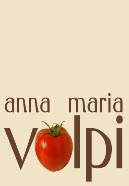




HOME PAGE >> Guest Cooks >>
Publication or use of pictures, recipes, articles, or any other material form my Web site, on or off-line without written permission from the author is prohibited. If you would like to use my articles on your Web site or in your publication, contact me for details. Avoid infringing copyright law and its consequences: read the article 7 Online Copyright Myths by Judith Kallos
Read our
DISCLAIMER and
PRIVACY POLICY
before using
our site
-------------------
Linking Policy
Advertise with us
DISCLAIMER and
PRIVACY POLICY
before using
our site
-
Advertise with us
Copyright © 2003 - 2011 Anna Maria Volpi - All Rights reserved.
Anna Maria's Open Kitchen Site Map
site map
recipes
policies
about us
Some More Hot Topics You'd Like to See adv.



Anna Maria Suggests
Extra-
The Best Selection of Italian Extra-
Buy from the source Authentic Aged Traditional Balsamic Vinegar from Italy
Sicily, Apulia, Lazio, Liguria, and More...The Best Selection of Succulent Italian Olives Oil
Infused Extra-
Spice up your dishes with Infused Flavored Italian Extra-
1/2 lb (250 gr) parsley
1 oz (30 gr) fresh mint
1 medium onion
2 - 3 tomatoes (about 1 lb, 440 gr)
1/2 teaspoon paprika
1 - 2 teaspoons salt
1/2 cup (120 cc) fresh lemon juice
1/2 teaspoon allspice, ground
1 oz (30 gr) bolghur # 1 (or fine)
1 cup (240 cc) extra-virgin olive oil
1 oz (30 gr) fresh mint
1 medium onion
2 -
1 -
1/2 teaspoon allspice, ground
1 oz (30 gr) bolghur # 1 (or fine)
1 cup (240 cc) extra-
Cut out the stems from the parsley.
Chop finely the parsley leaves and place in a bowl.
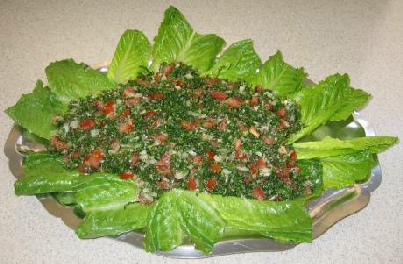
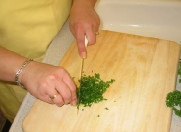
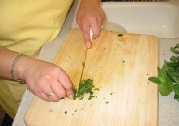
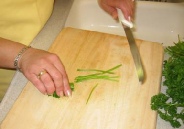
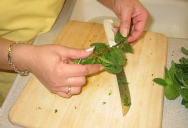
Separate the mint leaves from the stems.
Chop finely the mint leaves and combine them with the chopped parsley.
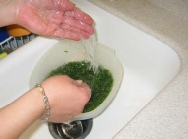
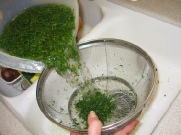
Drain in a fine colander. Transfer back to the bowl.
Wash the parsley / mint mix with fresh water.
When transferring the greens back to the bowl be careful to discard the last water that may contain soil and sand residues. Repeat the step of washing and draining until the water will be perfectly clear of residues. Leave the parley mix in the colander to drain thoroughly for at least one hour. Press the surface of the greens to squeeze all the water out. Transfer to a bowl. *** NOTE: Washing the chopped mint together with the parsley prevents also the mint from darkening.
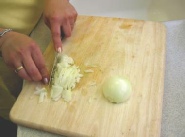
Finely chop the onion and combine to the parsley.
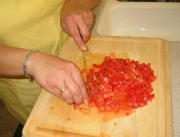
Finely dice the tomatoes and add it to the bowl.
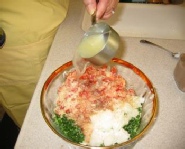
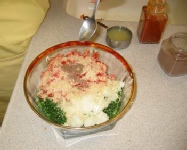
Add paprika, half of the lemon juice . . . .
. . . . the allspice . . . .
. . . salt . . . .
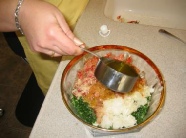
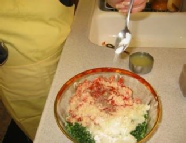
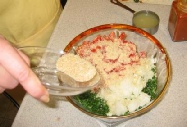
. . . olive oil . . . .
. . . and bolghur.
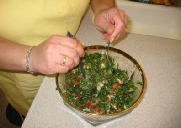
Mix thoroughly.
This is the moment of truth. It is impossible to say exactly how much of the ingredients is necessary to reach the proper balance. It depends on too many factors: the quantity of the parsley, the absorption of the bolghur, the strength of the lemon, etc.
Taste the tabouleh and add ingredients as necessary. It is better to be shy with the lemon as it is easy to add. Maybe the tabouleh will need little more oil, an extra touch of allspice and paprika, or salt.
Invite your friends and family to taste and get their opinion: it could be the start of an interesting debate on everyone’s perceptions. Enjoy the tabouleh with pita flat bread.
Taste the tabouleh and add ingredients as necessary. It is better to be shy with the lemon as it is easy to add. Maybe the tabouleh will need little more oil, an extra touch of allspice and paprika, or salt.
Invite your friends and family to taste and get their opinion: it could be the start of an interesting debate on everyone’s perceptions. Enjoy the tabouleh with pita flat bread.
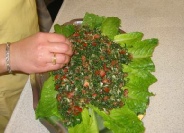
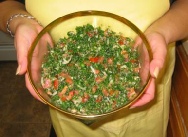
Tabouleh is now ready.
Arrange Tabouleh on a nice dish and garnish with salad leaves.
Tabouleh
Maro Tomassian
Guest Cook from LEBANON
When it comes to freshness nothing compares with the fragrances of the Mediterranean preparations, and their flavors and aromas.
Lebanese food is Mediterranean at its highest. It brings together the complexity of the European cooking with the pleasures of Eastern fragrances. Many traditional Lebanese dishes are simple preparations based on grains, pulses, vegetables and fruits, but the dish presentations are always artistic, and even the most basic dishes are beautifully garnished.
We joined Maro and her family for lunch on a beautiful Saturday afternoon at her home in Santa Clarita where she prepared many traditional dishes and Mezzeh's (appetizer or salad). Among others Maro showed us how to make the best Tabouleh, one of the most acclaimed Mediterranean recipes. It can be served as a salad with the entrée, or it can be placed next to a bowl of mixed nuts and shared in social occasions before dinner accompanied with Pita Bread.
Don’t be fooled by the apparent simplicity of the recipe. Tabouleh requires shopping for the freshest vegetables, patience in putting everything together, and good taste to balance all the ingredients perfectly.
Anna Maria Volpi
Bolghur (aka bulghur or bulgur or bulgar or burghul) is made by cleaning, parboiling, and drying the wheat. The grains are then ground (cracked) into different sizes, generally fine, medium and coarse.
In contrast to cracked wheat, bolghur is ready for steaming or boiling with minimal cooking. After soaking in water or broth, bolghur can be mixed with other ingredients without further cooking. Bolghur has a more distinctive nutty taste than simple cracked wheat.

From Armenian descent, born and raised in Lebanon, as a young girl Maro spent hours watching her mother cook for the family, and learning the techniques to make Lebanese dishes.